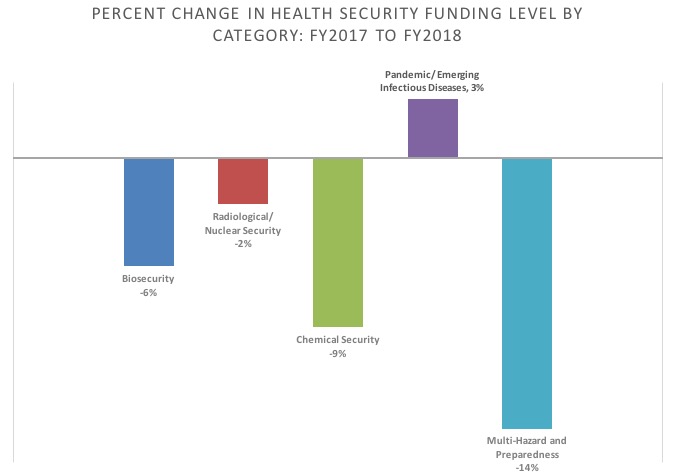President’s proposed FY2018 budget includes largest cut to health security programs in more than a decade
Annual analysis by Johns Hopkins Center for Health Security estimates decrease is 9 percent, totalling $1.25 billion
Center News
June 30, 2017 – A new report by the Johns Hopkins Center for Health Security has found that proposed funding in President Donald Trump’s budget request for FY2018 would cut health security programs by an estimated $1.25 billion, or 9 percent, the largest decrease in more than a decade.
The report, written by Senior Associate Crystal Watson, DrPH, MPH, Senior Associate Tara Kirk Sell, PhD, MA, and Senior Analyst Matthew Watson, and is the Center’s latest annual analysis of federal funding for health security–related programs in public health, health care, national security, and defense. All told, the President’s budget includes $12.45 billion for those programs, down significantly from $13.71 billion in FY2017 and from the FY2016 actual funding level of $13.99 billion.

“Budgets are a real-world expression of political priorities, and this budget suggests that health security is not a high priority for the Administration,” said Crystal Watson, lead author of the report. “Cuts of this magnitude will make it difficult for public health preparedness programs intended to protect civilians from chemical, biological, radiological, and nuclear threats to execute their respective missions.”
Center authors gathered and reviewed data from federal agency ‘‘Budgets in Brief,’’ agency congressional budget justifications, and personal contacts with agency representatives. They identified nearly 200 health security programs across 12 federal departments by prioritizing support for prevention, preparedness, and response, as well as related research efforts. Their analysis excluded programs focused on routine provision of health care, occupational health and safety, warfare between nation states, or protecting the warfighter with no stated or likely civilian applications now or in the future.
Programs are organized by department into 5 subcategories critical to strengthening health security:
- Multiple-Hazard and General Preparedness programs focus on multiple hazards or on building infrastructure and capacity to respond to large-scale health threats. These programs would be cut by 14 percent to $6.67 billion.
- Biosecurity programs focus on prevention, preparedness, and response to attacks on civilians with biological agents and accidental releases of biological material. These programs would receive $1.53 billion in FY2018, a decrease of 6 percent compared to FY2017.
- Radiological and Nuclear Security programs focus on prevention, preparedness, and consequence management of radiological and nuclear terrorism and large-scale radiological accidents. These programs would receive $2.48 billion, a decrease of 2 percent from the prior year.
- Chemical Security programs focus on prevention, preparedness, and response to large-scale acute chemical exposures of civilian populations, both intentional and accidental. These programs face a 9 percent cut, down to $389.7 million.
- Pandemic Influenza and Emerging Infectious Diseases programs focus on preparedness and response to large, naturally occurring, and potentially destabilizing epidemics. The President’s budget proposes a 3 percent increase for these programs to $1.39 billion.
Federal Funding for Health Security in FY2018
There are many specific cuts of particular concern. For example, the budget continues steep cuts to federal grant programs that support state and local preparedness personnel and capabilities, such as the Public Health Emergency Preparedness cooperative agreement, the Hospital Preparedness Program, and state and local FEMA grants. In addition, this budget calls for the elimination of Department of Homeland Security Science and Technology Directorate programs like the National Biodefense Analysis and Countermeasures Center, which is the only facility in the nation charged with bioforensics and biological threat characterization.
Overall funding for health security has decreased by roughly $1 billion since FY2010. The proposed FY2018 reductions would more than double that decrease.
This is the 14th year the Center has published an analysis of proposed federal spending on health security-related programs. The full report, published in the journal Health Security, is available at liebertpub.com.
About the Johns Hopkins Center for Health Security:
The Johns Hopkins Center for Health Security works to protect people from epidemics and disasters and build resilient communities through innovative scholarship, engagement, and research that strengthens the organizations, systems, policies, and programs essential to preventing and responding to public health crises. The Center is part of the Johns Hopkins Bloomberg School of Public Health and is located in Baltimore, Md.
